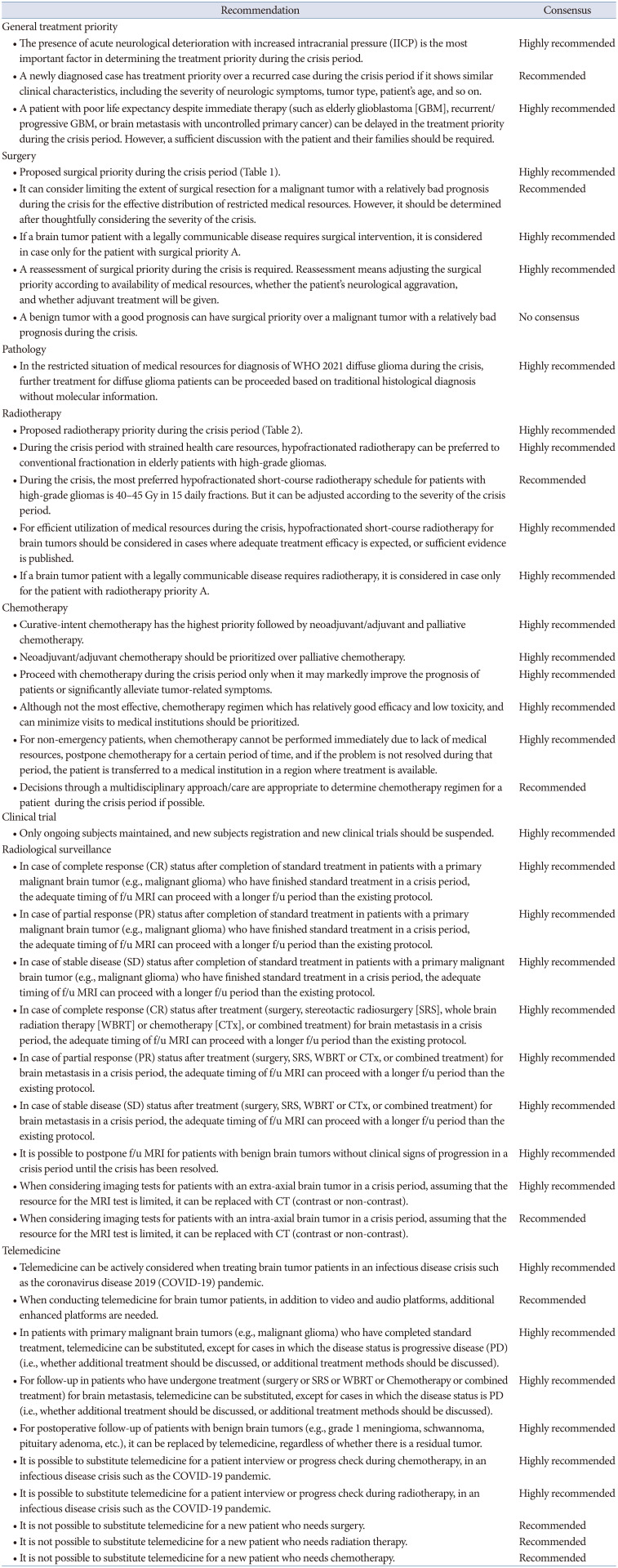1. Bernhardt D, Wick W, Weiss SE, Sahgal A, Lo SS, Suh JH, et al. Neurooncology management during the COVID-19 pandemic with a focus on WHO grades III and IV gliomas. Neuro Oncol. 2020; 22:928–935. PMID:
32369601.
2. Ramakrishna R, Zadeh G, Sheehan JP, Aghi MK. Inpatient and outpatient case prioritization for patients with neuro-oncologic disease amid the COVID-19 pandemic: general guidance for neuro-oncology practitioners from the AANS/CNS Tumor Section and Society for Neuro-Oncology. J Neurooncol. 2020; 147:525–529. PMID:
32274630.
4. Jones J, Hunter D. Consensus methods for medical and health services research. BMJ. 1995; 311:376–380. PMID:
7640549.
5. Keeney S, Hasson F, McKenna H. Consulting the oracle: ten lessons from using the Delphi technique in nursing research. J Adv Nurs. 2006; 53:205–212. PMID:
16422719.
6. Jheon S, Ahmed AD, Fang VW, Jung W, Khan AZ, Lee JM, et al. Thoracic cancer surgery during the COVID-19 pandemic: a consensus statement from the thoracic domain of the Asian Society for Cardiovascular and Thoracic Surgery. Asian Cardiovasc Thorac Ann. 2020; 28:322–329. PMID:
32609557.
7. Burke JF, Chan AK, Mummaneni V, Chou D, Lobo EP, Berger MS, et al. Letter: the coronavirus disease 2019 global pandemic: a neurosurgical treatment algorithm. Neurosurgery. 2020; 87:E50–E56. PMID:
32242901.
8. Zoia C, Bongetta D, Veiceschi P, Cenzato M, Di Meco F, Locatelli D, et al. Neurosurgery during the COVID-19 pandemic: update from Lombardy, northern Italy. Acta Neurochir (Wien). 2020; 162:1221–1222. PMID:
32222820.
9. Gupta T, Singh VP, Balasubramian A, Menon H, Kurkure PA, Kumar S, et al. ISNO position statement on treatment guidance in neuro-oncology during pandemics. Neurol India. 2020; 68:769–773. PMID:
32859812.
12. Wee CW, Kim IH, Park CK, Kim N, Suh CO, Chang JH, et al. Chemoradiation in elderly patients with glioblastoma from the multi-institutional GBM-molRPA cohort: is short-course radiotherapy enough or is it a matter of selection? J Neurooncol. 2020; 148:57–65. PMID:
32361863.
13. Mak KS, Agarwal A, Qureshi MM, Truong MT. Hypofractionated short-course radiotherapy in elderly patients with glioblastoma multiforme: an analysis of the national cancer database. Cancer Med. 2017; 6:1192–1200. PMID:
28440040.
14. Roa W, Brasher PM, Bauman G, Anthes M, Bruera E, Chan A, et al. Abbreviated course of radiation therapy in older patients with glioblastoma multiforme: a prospective randomized clinical trial. J Clin Oncol. 2004; 22:1583–1588. PMID:
15051755.
15. Roa W, Kepka L, Kumar N, Sinaika V, Matiello J, Lomidze D, et al. International atomic energy agency randomized phase III study of radiation therapy in elderly and/or frail patients with newly diagnosed glioblastoma multiforme. J Clin Oncol. 2015; 33:4145–4150. PMID:
26392096.
16. Malmström A, Grønberg BH, Marosi C, Stupp R, Frappaz D, Schultz H, et al. Temozolomide versus standard 6-week radiotherapy versus hypofractionated radiotherapy in patients older than 60 years with glioblastoma: the Nordic randomised, phase 3 trial. Lancet Oncol. 2012; 13:916–926. PMID:
22877848.
17. Tabrizi S, Trippa L, Cagney D, Tanguturi S, Ventz S, Fell G, et al. A quantitative framework for modeling COVID-19 risk during adjuvant therapy using published randomized trials of glioblastoma in the elderly. Neuro Oncol. 2020; 22:918–927. PMID:
32339235.
20. Linz U. Commentary on effects of radiotherapy with concomitant and adjuvant temozolomide versus radiotherapy alone on survival in glioblastoma in a randomised phase III study: 5-year analysis of the EORTC-NCIC trial (Lancet Oncol. 2009;10:459-466). Cancer. 2010; 116:1844–1846. PMID:
20151424.
21. Sher DJ, Henson JW, Avutu B, Hochberg FH, Batchelor TT, Martuza RL, et al. The added value of concurrently administered temozolomide versus adjuvant temozolomide alone in newly diagnosed glioblastoma. J Neurooncol. 2008; 88:43–50. PMID:
18231723.
22. Kim BS, Seol HJ, Nam DH, Park CK, Kim IH, Kim TM, et al. Concurrent chemoradiotherapy with temozolomide followed by adjuvant temozolomide for newly diagnosed glioblastoma patients: a retrospective multicenter observation study in Korea. Cancer Res Treat. 2017; 49:193–203. PMID:
27384161.
23. Cairncross G, Wang M, Shaw E, Jenkins R, Brachman D, Buckner J, et al. Phase III trial of chemoradiotherapy for anaplastic oligodendroglioma: long-term results of RTOG 9402. J Clin Oncol. 2013; 31:337–343. PMID:
23071247.
24. Cairncross JG, Wang M, Jenkins RB, Shaw EG, Giannini C, Brachman DG, et al. Benefit from procarbazine, lomustine, and vincristine in oligodendroglial tumors is associated with mutation of IDH. J Clin Oncol. 2014; 32:783–790. PMID:
24516018.
25. van den Bent MJ, Brandes AA, Taphoorn MJ, Kros JM, Kouwenhoven MC, Delattre JY, et al. Adjuvant procarbazine, lomustine, and vincristine chemotherapy in newly diagnosed anaplastic oligodendroglioma: long-term follow-up of EORTC brain tumor group study 26951. J Clin Oncol. 2013; 31:344–350. PMID:
23071237.
26. Gonzalez-Aguilar A, Reyes-Moreno I, Peiro-Osuna RP, Hernandez-Hernandez A, Gutierrez-Aceves A, Santos-Zambrano J, et al. Radiotherapy plus temozolomide or PCV in patients with anaplastic oligodendroglioma 1p19q codeleted. Rev Neurol. 2018; 67:293–297. PMID:
30289152.
27. Jaeckle KA, Ballman KV, van den Bent M, Giannini C, Galanis E, Brown PD, et al. CODEL: phase III study of RT, RT + TMZ, or TMZ for newly diagnosed 1p/19q codeleted oligodendroglioma. Analysis from the initial study design. Neuro Oncol. 2021; 23:457–467. PMID:
32678879.
28. Weller M, Preusser M. How we treat patients with brain tumour during the COVID-19 pandemic. ESMO Open. 2020; 4(Suppl 2):e000789. PMID:
32409298.
29. Ekeland AG, Bowes A, Flottorp S. Effectiveness of telemedicine: a systematic review of reviews. Int J Med Inform. 2010; 79:736–771. PMID:
20884286.
30. de la Torre-Díez I, López-Coronado M, Vaca C, Aguado JS, de Castro C. Cost-utility and cost-effectiveness studies of telemedicine, electronic, and mobile health systems in the literature: a systematic review. Telemed J E Health. 2015; 21:81–85. PMID:
25474190.
31. Lee MH, Jang SR, Lee TK. The direction of neurosurgery to overcome the living with COVID-19 era : the possibility of telemedicine in neurosurgery. J Korean Neurosurg Soc. 2023; 03. 10. DOI:
10.3340/jkns.2022.0211. [Epub].







 PDF
PDF Citation
Citation Print
Print




 XML Download
XML Download